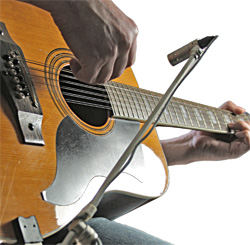
Suppose the close mic is picking up a loud voice, and the distant mic is picking up a quiet acoustic guitar.
You’ve placed the mics following the 3:1 rule, but you have to turn up the guitar-mic gain a lot because the guitar is so quiet.
If so, the 9 dB separation might be negated. That is, the vocal signal in the guitar mic might be less than 9 dB below the vocal signal in the vocal mic, because the guitar mic’s gain is so high.
So there’s more to it than just the 3:1 placement. The idea is to get at least 9 dB difference between mic levels for the same instrument.
And remember – you want at least 9 dB of separation, not exactly 9 dB of separation.
Tips & Techniques
Here are some ways to prevent phase cancellations between mics that are fed to the same channel:
• Place mics close, then turn down the excess bass with EQ.
• Spread instruments farther apart.
• Use a pickup on the guitar instead of a mic.
• Delay the vocal mic signal by about 1 msec (millisecond). Then it will align in time with the vocal signal picked up by the guitar mic.
• Use directional mics, and angle the mics away from each other. For example, aim the vocal mic up and aim the guitar mic down. If the close and distant mics are two cardioids aiming opposite directions, the mics can be closer than 3:1 and still get enough separation.
• Use coincident directional mics, aimed up and down, so that the vocal signal arrives at both mics at the same time.
Another tip to prevent phase cancellations: Don’t use two mics when one will do the job.
For example, use just one mic on a lectern. If you must use two mics mixed to the same channel, place them so their grilles touch, one above the other. That way, there is no delay between their signals, and thus no comb filtering.
Exceptions
What if two mics pick up the same instrument at different distances and they are NOT mixed to the same channel? The result is stereo images, rather than phase cancellations.
The location of the instrument’s image between the house loudspeakers depends on the delay between mics, the levels at those mics, and where they are panned.
Suppose one mic is panned hard left and the other is panned hard right. If the delay between mic signals is 0 msec, and the level is the same at both mics, the image will appear in the “center” between the loudspeakers.
If the delay is 0.5 msec, the image will be about halfway off-center. If the delay is 1.5 msec or more, the image will be at one loudspeaker.
AES and SynAudCon member Bruce Bartlett is a recording engineer, audio journalist, and microphone engineer. His latest books are “Practical Recording Techniques 5th Ed.” and “Recording Music On Location.”
